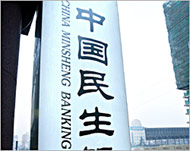Foreign banks prepare to enter China
The end of 2003 witnessed a flurry of banking regulatory activity in preparation for the financially auspicious date of 1 December 2006 when China provides full market access for foreign banks in accordance with WTO rules.

At present, limited to foreign currency transactions – and in some municipalities – local currency (RMB) business with corporations and foreign banks are busy positioning themselves to enter a market where household savings alone exceed $1.2 trillion.
Despite all the earlier bold headlines proclaiming foreign bank invasions, industry experts are unsure as to how widely foreign banks can tap the market.
On the face of it, there is not much credible competition. Local banks provide poor and bureaucratic service with few savings options for account holders.
Technologically behind their foreign counterparts, there is currently no credit appraisal system, (less than 1% of the 560 million banking cards in circulation are credit cards).
Nor are banks friendly towards issuing loans to private companies, unless of course, there are kickbacks.
On top of this, banks are staggering under a mountain of non-performing loans (NPLs), a figure estimated to be as high as $500bn, or half of the country’s annual economic output.
Partly as a result, Standard and Poor recently downgraded eight of China’s larger banks to junk-bond status.
 |
|
China holds immense promise to |
However, according to industry specialist Lisa Tian of consulting group APCO, foreign banks are still a long way behind their local rivals.
“Even when the market opens in 2006-2007 I would not expect foreign banks to be fully prepared,” she said. “They will have to adjust to local regulations, promote their corporate identity and think carefully about their customer base. The fact they are unknown will also work against them, people won’t trust an unknown brand.”
Sensing opportunity
However, many foreign banks believe there is room to operate. In Shanghai alone, there are 57 foreign bank branches, with nationwide registered assets totaling $47bn.
Technologically proficient, consumer orientated and globally experienced, many foreign banks feel they have something to offer.
Rising to the challenge of capturing a share of the retail as well as corporate market, foreign bank leader HSBC has been opening as many branches as legally possible, no small feat given the requirements – a two-year representative office presence along with $37-62m in registered capital.
“Foreign banks need to move into an inorganic role, such as aiding and investing in local banks. There are very few banks for whom China is extremely important” Lance Brown, |
With nine branches already in existence and various representative offices across the country, the bank covers 11 cities.
“We aim to be number one and we will do what we have to do to maintain that position,” proclaimed company representative Gareth Hewett.
Given the costs and in some people’s minds, the fruitlessness of investing in bricks and mortar, moneymaking alternatives are needed.
“Currently Chinese banks make 90% of their profits from lending whereas our bank makes 50% from lending, 50% from fees,” said Standard Chartered chairman Lance Brown.
Local muscle
With more than 100,000 branches between them, the big four state banks occupy a dominant position, both physically and psychologically.
“Foreign banks need to move into an inorganic role, such as aiding and investing in local banks,” suggested Brown before adding that because of the restrictions in the market, “there are very few banks for whom China is extremely important.”
Although Standard Chartered is yet to find a partner, both HSBC and Citibank have invested in local financial houses.
According to Hewett, their 8% stake in the Bank of Shanghai gives them an inside view of the financial markets, a valuable opportunity given that foreign banks are still permitted to operate in only 13 major cities.
“It is all about gaining experience. Our investment gives us a seat on the board, access to company research and knowledge on training and technical management,” he said.
The news in late December that both HSBC and Citibank would be able to issue credit cards through their respective partners, is perhaps indicative of how their investment is paying off.
Close competition
 |
|
Notorious for poor services, |
To more cynical observers though, having a better operational structure than local competitors will not necessarily equal success.
“Chinese banks are improving and they are becoming very aggressive in providing cheap loans and funds,” stated Norio Tanaka of Mitsubishi Bank. “Plus, the government wants to keep Chinese companies for Chinese banks.”
Certainly, China’s main banks should not be written off just yet, despite their poor operational and credit history.
Speaking at a recent conference, People’s Bank special adviser, Zhu Min suggested services and management were being improved, a statement that was on the face of it supported by statistics showing a drop in the rate of NPLs.
At one bank, the China Construction Bank, NPLs apparently fell from 20.3% of total loans to 15.3% in a three-year period.
In addition, the government announced a $45bn recapitalization programme aimed at improving the financial status of two of the country’s larger banks, the Bank of China and China Construction Bank.
|
“You need to open in China step by step” Chieben Huang, |
Seen as the last in a string of bailouts, it will help smooth out the balance sheets prior to their public listing.
The reality is that for most foreign banks, a more cautious wait and see policy appears to be in place. “You need to open in China step by step,” suggested Australia and New Zealand Bank representative, Chieben Huang.
Citing China’s fixed rates of lending and subsequent inability to price risk as a leading reason, he suggested most banks were waiting for further regulatory changes before expanding.
Even through expansion, only the banking heavyweights will be able to offer anything other than a niche market operation.
At the Arab Bank, deputy representative Stephen Mao is very excited by future retail potential, but admitted Chinese clients will be limited to those doing business in the Middle East.
According to Zhu Min, the government envisages a highly competitive environment in 2006-2007, as local banks rush to upgrade their operations.
How successful local banks are in their restructuring remains to be seen. If past experience is anything to go on though, the results will be mixed.